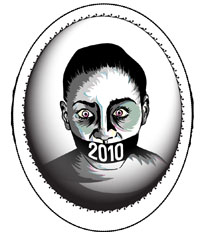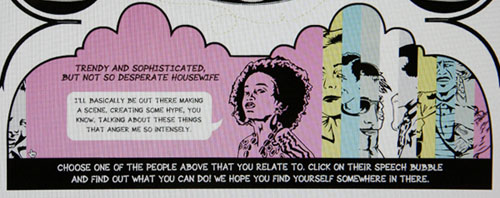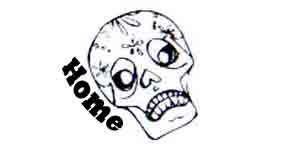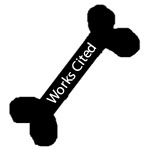
In light of the fact that STOP was started by South Africans in anticipation of the effect that the World Cup would have on their country, my reading of the webpage may miss some denotations that would be obvious in South Africa. A sign's meaning depends on the "bifacial unity of a signifier and signified" and that unity is determined culturally (Gottdiener 6). However, I recognize many of the cultural references made and my analysis will be a reflexive process which demonstrates the power of signs to cross cultures and generate an awareness of the things which have greater salience to me because of my culture.
The banner at the top of the page is not the largest visual, but has greater salience due to its position at the top of the page, title, striking image and springboard for other links. The spatial organization and written text of the banner draw the audience in to further explore the site (Rose 100). The illustration of a scared woman in the center of the banner quickly gives a visual connection to the topic of human trafficking.
|
The image shows the head and shoulders of a woman framed in an oval. She is drawn in black and
white, with the only hint of color being in and around her widely opened eyes. The woman's mouth
is covered by tape with the year 2010 written on it. Theo van Leeuwen says that there is an
"unwritten 'dictionary' of poses which is known to everyone who is at all exposed to mass media,"
and the body language shown by the woman would universally be understood as a cry for help
(van Leeuwen 97). The woman's eyes are opened wide, easily recognized as an indicator of fear or
surprise, but the anchoring of the text and the tape across her mouth point to fear. Also, her
face seems to be stretching away from her body, out towards the audiences in a plea for a rescuer.
The colors around her eyes are grayish greens and purples, but the colors constitute a polysemic
sign with multiple meanings (Rose 98).
|

|
On one level, the colors could represent the fact that people who are enslaved lose control of their lives and thus lose much of their identity, with only the eyes revealing that a real person exists behind the objectified body. The eyes are often referred to as the "window to the soul, so the selective coloring of the eyes could point to the fact that the slave only has their soul left after everything else, including their voice, is taken. Another reading of the color could suggest the bruises left by a cruel enslaver, as the greens and purples are reminiscent of the coloring of bruises. In both cases, the scared body language, colors, and restrictive tape suggest that this woman is a victim of the sex slave trade. The fact that it is a woman does represent the statistics that more women are trafficked, especially as sex slaves, but also furthers ideologies about women always being the helpless victim (Human Trafficking 1).
An interesting visual aspect of the website is the repeated theme of skulls and bones. They are use as decorative anchoring images throughout the website. The use of skulls and bones are usually indicators of death or dying, but since these images are used decoratively, it confuses the viewer with how they are supposed to think about death. While the flowers and heart on the skull make light of death, the whole point of the website is to show the horrendous reality of human trafficking.
Below the portrait are three links to the initiatives, signups, and promulgation possibilities, flanked by shapes suggesting televisions with links to two different videos. More importantly for our current intentions, a large interactive graphic takes up a good bit of the rest of the page. The graphic consists of different tabs depicting categories of people each with an illustration and text. The tabs are different colors, in the same muted color palette as the rest of the site, and slide back to reveal more information when they are rolled over with the mouse.
Though these illustrations are anchored by a caption, even without captions "people can be visually represented...as a social type" through cultural characteristics such as objects, clothing, or hairstyle, or physiognomic features such as facial features or expressions (van Leeuwen 95). Van Leeuwen writes that "the more these stereotypes overshadow a person's individual features, the more that person is represented as a type" (van Leeuwen 95). The fact that these are rough illustrations definitely plays into that theory, supported by the text, below which tells the reader to "choose one of the people above that you relate to" and then click on their speech bubble to find out what they can do. They explicitly say that they hope the viewer can find themselves "somewhere in there," and provide different class, gender, and age roles with which people can identify. STOP outlines eleven different possible societal roles: the Young Adult in the Making, the Trendy and Sophisticated, but Not So Desperate Housewife, the Cool Do-It-All Mommy, the Not So Slacky Student Slacker, the I'm a Guy...With Hormones, the Edu-Crea-Tors, the Handsome, Rich, and Influential Business Man, the Ageless Ager, the Daddy to the People, the Artsy Fartsy Da Vinci Prodigy, and the 'Cause You Gotta Have Faith. The roles are obvious stereotypes, but take advantage of stereotypes to make a point about the possibility for anyone to get involved in the cause.


